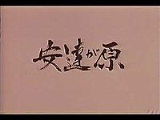
Adachi-ga Hara
Encyclopedia
is the fifth anime
episode in the Lion Books
series. This episode is the only one in the series released to theater first (unlike the rest of the series, which was released directly to video), making it not an OVA
.
theatre drama Ôshû Adachi-ga-Hara, (The Ballad of Sodehagi).
Anime
is the Japanese abbreviated pronunciation of "animation". The definition sometimes changes depending on the context. In English-speaking countries, the term most commonly refers to Japanese animated cartoons....
episode in the Lion Books
Lion Books (manga)
was a 1950s Japanese manga series published by Shueisha into the Omoshiro Book as a supplement. The same company would publish Lion Books II into Weekly Shōnen Jump in the 1970s, which would commonly be referred to as "The New Lion Books"...
series. This episode is the only one in the series released to theater first (unlike the rest of the series, which was released directly to video), making it not an OVA
Original video animation
, abbreviated as media , are animated films and series made specially for release in home-video formats. The term originated in relation to Japanese animation...
.
Story
The story is a sci-fi fantasy about an old woman who meets the young space pilot Jes, exiled for trying to overthrow Earth's pro-independence prescient Phippo and pining of his girlfriend Anny. The story is based on the classical Japanese nohNoh
, or - derived from the Sino-Japanese word for "skill" or "talent" - is a major form of classical Japanese musical drama that has been performed since the 14th century. Many characters are masked, with men playing male and female roles. Traditionally, a Noh "performance day" lasts all day and...
theatre drama Ôshû Adachi-ga-Hara, (The Ballad of Sodehagi).
Staff
- Director: Hisashi Sakaguchi
- Storyboard: Hisashi Sakaguchi
- Music: Reijiro Koroku
- Original creator: Osamu TezukaOsamu Tezukawas a Japanese cartoonist, manga artist, animator, producer, activist and medical doctor, although he never practiced medicine. Born in Osaka Prefecture, he is best known as the creator of Astro Boy, Kimba the White Lion and Black Jack...
- Character Design: Hisashi Sakaguchi
- Art director: Mieko Ichihara
- Art: Hisashi Sakaguchi
- Animation director: Junji Kobayashi
- Director of Photography: Hisao Shirai

